
The Valour class is a class of frigates built for the South African Navy. Part of the MEKO family of warships, the German shipbuilder Blohm+Voss officially designate the class as the MEKO A-200SAN.

Combined diesel and gas (CODAG) is a type of propulsion system for ships that need a maximum speed that is considerably faster than their cruise speed, particularly warships like modern frigates or corvettes.

The General Electric LM2500 is an industrial and marine gas turbine produced by GE Aviation. The LM2500 is a derivative of the General Electric CF6 aircraft engine.

HMS Exmouth was a Royal Navy anti-submarine warfare frigate of the Blackwood or Type 14 class.

The Type 41 or Leopard class were a class of anti-aircraft defence frigates built for the Royal Navy and Indian Navy in the 1950s. The Type 41, together with the Type 61 variant introduced diesel propulsion into the Royal Navy, the perceived benefits being long range, low fuel use, reduced crew, and reduced complexity.
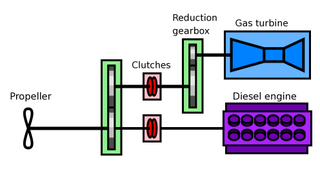
Combined diesel or gas (CODOG) is a type of propulsion system for ships that need a maximum speed that is considerably faster than their cruise speed, particularly warships like modern frigates or corvettes.
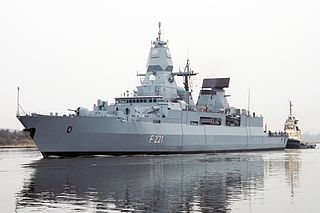
The F124 Sachsen class is the German Navy's latest class of air-defense frigates. The design of the Sachsen-class frigate is based on that of the F123 Brandenburg class but with enhanced stealth features designed to deceive an opponent's radar and acoustic sensors. The class incorporates an advanced multifunction radar APAR and a SMART-L long-range radar which is purported to be capable of detecting stealth aircraft and stealth missiles.
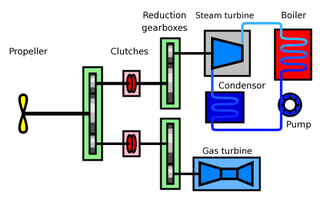
Combined steam and gas (COSAG) is a propulsion system for ships using a combination of steam turbines and gas turbines to power the shafts.
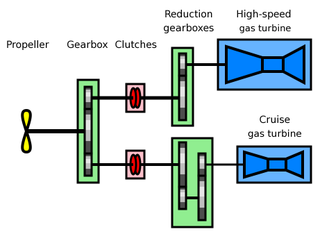
Combined gas or gas (COGOG) is a propulsion system for ships using gas turbine engines.

Combined diesel-electric and gas (CODLAG) is a modification of the combined diesel and gas propulsion system for ships. A variant, called the combined diesel-electric or gas (CODLOG) system, contains the same basic elements but will not allow simultaneous use of the alternative drive sources.
The Type system is a classification system used by the British Royal Navy to classify surface escorts by function. The system evolved in the early 1950s, when the Royal Navy was experimenting with building single-purpose escort vessels with specific roles in light of experience gained in World War II. The original numbering scheme was:

MILGEM project (Turkish:Milli Gemi Projesi, English: National Ship Project) is a national warship program of the Republic of Turkey. Managed by the Turkish Navy, the project aims at developing multipurpose corvettes, frigates and destroyers that can be deployed in a range of missions, including reconnaissance, surveillance, early warning, anti-submarine warfare, surface-to-surface and surface-to-air warfare, and amphibious operations.

Marine propulsion is the mechanism or system used to generate thrust to move a watercraft through water. While paddles and sails are still used on some smaller boats, most modern ships are propelled by mechanical systems consisting of an electric motor or internal combustion engine driving a propeller, or less frequently, in pump-jets, an impeller. Marine engineering is the discipline concerned with the engineering design process of marine propulsion systems.

JS Kashima (TV-3508) is a training ship of the Japan Maritime Self-Defense Force (JMSDF). Built to a unique design during the mid-1990s, Kashima is flagship of the JMSDF Training Fleet. The name Kashima comes from the famous Shinto Kashima Shrine in Ibaraki prefecture, located to the northeast of Tokyo.

Integrated electric propulsion (IEP), full electric propulsion (FEP) or integrated full electric propulsion (IFEP) is an arrangement of marine propulsion systems such that gas turbines or diesel generators or both generate three-phase electricity which is then used to power electric motors turning either propellers or waterjet impellors. It is a modification of the combined diesel-electric and gas propulsion system for ships which eliminates the need for clutches and reduces or eliminates the need for gearboxes by using electrical transmission rather than mechanical transmission of energy, so it is a series hybrid electric propulsion, instead of parallel.

The Rolls-Royce Marine Olympus is a marine gas turbine based on the Rolls-Royce Olympus aircraft turbojet engine.

Alpino was a Alpino-class frigate operated by the Italian Navy during the Cold War. Launched in 1967, the vessel was optimised for anti-submarine warfare based on two Agusta-Bell AB.204 helicopters protected by a telescopic hangar and a variable-depth sonar (VDS). It was also the first frigate to use gas turbines, in a combined diesel and gas (CODAG) arrangement. In 1973, the frigate undertook the longest continuous voyage of an Italian naval ship, covering over 7,000 nautical miles, and continued to serve in the anti-submarine role until 1996, by which time the helicopters had been replaced by the more capable Agusta-Bell AB-212ASW and the VDS taken out of service. In 1997, the ship was recommissioned as a support ship for mine warfare, at the same time as the ability to operate one of the helicopters was removed. The frigate was decommissioned in 2006.
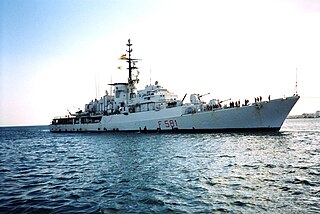
Carabiniere was a frigate operated by the Italian Navy. Launched in 1967, the vessel served in the anti-submarine role during the Cold War until 1992. The ship was then recommissioned as a testing platform for new weapons systems, including Aster, finally retiring in 2008.
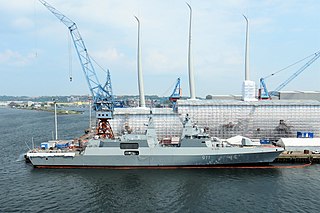
El Moudamir (911) is the second Erradii-class frigate of the Algerian National Navy.


















